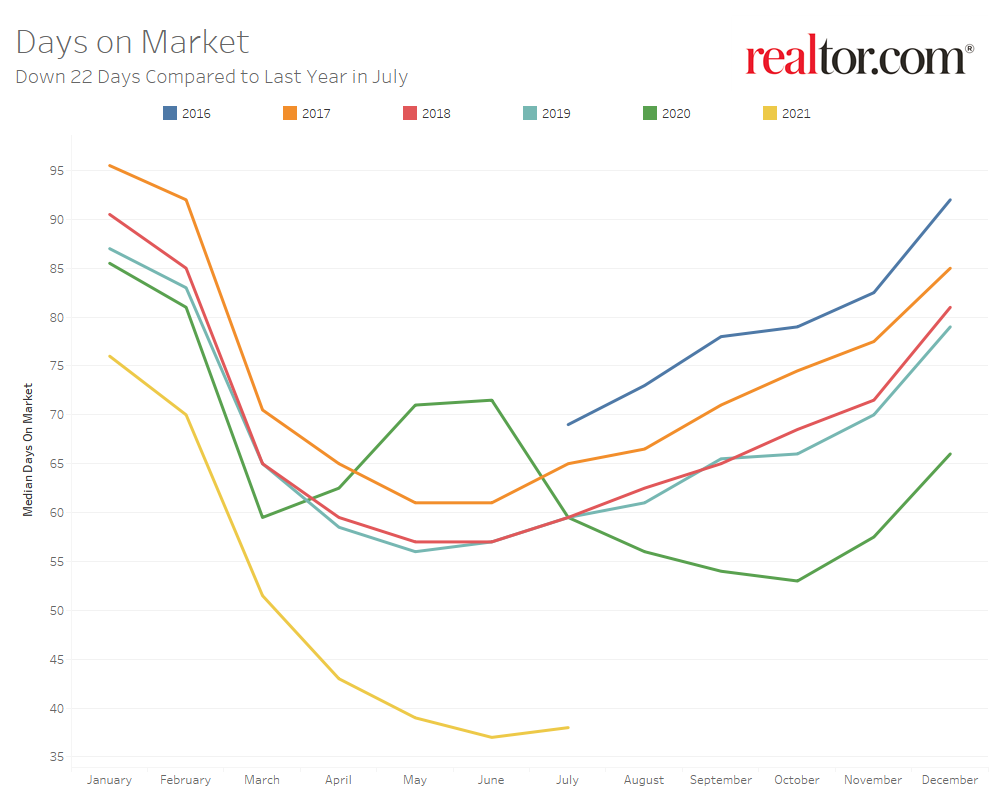July 2021 Housing Market Trends Report
- The national inventory of active listings declined by 33.5% over last year, while the total inventory of unsold homes, including pending listings, declined by 17.3%.
- Newly listed homes on the market are up 6.5% nationally compared to a year ago, and 11.1% higher for large metros over the past year. Sellers are still listing at rates lower than previous years, however.
- The July national median listing price for active listings was $385,000, up 10.3% compared to last year. Large metros saw an average price gain of 3.9% compared to last year.
- Nationally, the typical home spent 38 days on the market in July, much less than the 60 days during the same month in 2020.
Realtor.com®’s July housing data release reveals signs of a positive change in the market for homebuyers. Median listing prices are continuing to cool, driven by an increase in lower-priced homes in many metros. New sellers are beginning to enter the market at close to normal levels and while their property values remain elevated, they may have to consider pricing more competitively in the near future.
Selling Activity Continues to Normalize, and Smaller Homes Are Gaining in Inventory Share
Nationally, the inventory of homes actively for sale in July decreased by 33.5% over the past year, a lower rate of decline compared to the 43.1% drop in June. A deceleration in the decline of inventory means the market is heading in an encouraging direction, but active inventory still remains historically low. This decline amounted to 305,000 fewer homes actively for sale on a typical day in July compared to the previous year. The total number of unsold homes nationwide–a metric that includes active listings and listings in various stages of the selling process that are not yet sold– is down 17.3% percent from July 2020.
In July, newly listed homes grew by 6.5% on a year-over-year basis, and remained stable on a month-over-month basis. Typically, fewer newly listed homes appear on the market in the month of July compared to June. This year, homes are continuing to be listed at seasonally-elevated rates later into the summer season, a welcome sign for a tight housing market. However, newly listed homes are still down 9.5% from the typical rate of newly listed homes in 2017 to 2019.
These newly listed homes tend to be smaller in size than last year, shifting the mix of inventory toward smaller homes compared to last year. Looking at the single family home category alone, the share of homes having between 750 and 1,750 square feet increased from 30.2% in July 2020 to 36.3% in July 2021, while the inventory of homes having between 3,000 and 6,000 square feet decreased from 24.2% to 20.1%.
The inventory of homes actively for sale in the 50 largest U.S. metros overall decreased by 28.1% over last year in July, a large slowdown in the rate of decline compared to last month’s 40.5% decrease. Regionally, the inventory of homes in southern metros is still showing the largest year-over-year decline (-39.9%). While newly listed homes are now increasing in most southern metros, selling activity remains well-below typical 2017 to 2019 levels in the South, while new listings are catching up to typical levels more quickly in the Northeast, Midwest, and West.
Markets which are seeing the largest year-over-year growth in newly listed homes include Columbus (+42.9%), Baltimore (+36.9%), and Cleveland (+35.8%). Markets which are still seeing a decline in newly listed homes compared to last year include Nashville (-26.5%), Raleigh (-19.8%), and New York (-16.0%).
While Homes Are Still Selling Quickly, a More Typical Seasonal Slowdown Emerges
The typical home spent 38 days on the market this July, 22 days less than last year. Homes are still being quickly snapped up as demand remains elevated, but the time a typical listing spends on the market is beginning to conform to seasonal norms. While last year the time on market continued to decline until October, this year, time on market in July increased over June, following a more typical seasonal trend.
In the 50 largest U.S. metros, the typical home spent 32 days on the market, and homes spent 17 days less on the market, on average, compared to last July. Among these 50 largest metros, the time a typical property spends on the market has decreased most in large metros in the South (-22 days), followed by the Midwest (-14 days), West (-13 days), and Northeast (-11 days).
Among larger metropolitan areas, homes saw the greatest yearly decline in time spent on market in Miami (-61 days), Raleigh (-33 days) and Jacksonville (-30 days). No metros saw days on market increase compared to last year in July.
Listing Prices Reflect More Affordable Inventory
The median national home price for active listings remained stable from June to July, at $385,000. The median listing price grew by 10.3% over last year, lower than last month’s growth rate of 12.7%. This marks the third month in a row when the annual growth rate has decreased.
While median listing price growth is slowing down, this doesn’t reflect declining home values, but instead reflects a change in the mix of inventory available for sale this past month compared to last year. Using the median listing price of a typical 2,000-square-foot single family home as an example, its median listing price is now 18.6% higher than last year and is not yet showing signs of moderation. The inventory of 2,000-square-foot single family homes is also declining less than the total inventory of homes (-21.9% compared to 33.5% overall), and this is driven by more sellers listing homes of this size and other smaller sized homes. The inventory of newly-listed 2,000-square-foot single family homes has grown by 18.7% over the past year, while all new listings grew by only 6.5%.
Active listing prices in the nation’s largest metros grew by an average of 3.9% compared to last year, lower than last month’s rate of 5.3%. Price growth in the nation’s largest metros is cooling slightly faster than other areas across the country, but the reasons why are positive. The median listing price of 22 out of the 50 largest markets is decreasing on a year-over-year basis, but our data shows that this is due to a positive change in the mix of what is being listed for sale. The inventory of existing 2000 sq. ft. single family homes in all of these 22 metros is now increasing or has a less negative growth rate than all homes, and a further 20 of these 22 metros are seeing the listing prices of these benchmark homes continuing to increase. For homebuyers, this means that there may be more affordable inventory available depending on their metro-area. For home sellers, this means that while their home values are still growing, they may need to consider pricing more competitively than they have in the past.
Austin (+36.6%), Las Vegas (+20.6%), and Riverside (+20.0%), posted the highest year-over-year median list price growth in July.
Regional Statistics (50 Largest Metro Combined Average)
| Region | Active Listing Count YoY | New Listing Count YoY | Median Listing Price YoY | Median Days on Market Y-Y |
| Midwest | -16.2% | 19.8% | -5.4% | -14 days |
| Northeast | -21.7% | 2.4% | -0.6% | -11 days |
| South | -39.9% | 9.6% | 7.2% | -22 days |
| West | -23.3% | 11.3% | 9.7% | -13 days |
July 2021 Housing Overview by Top 50 Largest Metros
| Metro | Median Listing Price | Median Listing Price YoY | Median Listing Price 2000 Sq. Ft. Single Family Home | Median Listing Price 2000 Sq. Ft. Single Family Home YoY | Active Listing Count YoY for 2000 Sq. Ft. Single Family Home | Active Listing Count YoY | New Listing Count YoY | Median Days on Market | Median Days on Market YoY |
| Atlanta-Sandy Springs-Roswell, Ga. | $400,000 | 14.2% | $335,000 | 24.9% | -1.1% | -41.3% | 9.4% | 31 | -19.5 |
| Austin-Round Rock, Texas | $536,000 | 36.6% | $482,000 | 38.6% | 9.8% | -44.0% | 12.7% | 20 | -24.5 |
| Baltimore-Columbia-Towson, Md. | $349,000 | -1.7% | $398,000 | 6.1% | 5.4% | -18.5% | 36.9% | 34 | -9 |
| Birmingham-Hoover, Ala. | $270,000 | -1.8% | $256,000 | 6.2% | -30.8% | -34.0% | 12.4% | 35 | -21.5 |
| Boston-Cambridge-Newton, Mass.-N.H. | $679,000 | 0.6% | $603,000 | 3.6% | 7.3% | -22.6% | -10.7% | 30 | -7 |
| Buffalo-Cheektowaga-Niagara Falls, N.Y. | $240,000 | -1.0% | $272,000 | 11.6% | -11.1% | -14.8% | 3.4% | 30 | -9.5 |
| Charlotte-Concord-Gastonia, N.C.-S.C. | $389,000 | 5.3% | $346,000 | 15.6% | -15.7% | -37.0% | 6.4% | 28 | -20.5 |
| Chicago-Naperville-Elgin, Ill.-Ind.-Wis. | $350,000 | 0.4% | $351,000 | 13.6% | -9.7% | -21.5% | 1.1% | 35 | -7 |
| Cincinnati, Ohio-Ky.-Ind. | $330,000 | -3.1% | $281,000 | 8.4% | 24.4% | -15.3% | 16.0% | 30 | -17 |
| Cleveland-Elyria, Ohio | $215,000 | -8.6% | $202,000 | 3.0% | 36.3% | -8.9% | 35.8% | 36 | -15.5 |
| Columbus, Ohio | $305,000 | -8.1% | $324,000 | 5.0% | 15.0% | -6.8% | 42.9% | 17 | -20.5 |
| Dallas-Fort Worth-Arlington, Texas | $395,000 | 9.8% | $345,000 | 21.7% | -24.4% | -47.3% | 6.7% | 29 | -18 |
| Denver-Aurora-Lakewood, Colo. | $600,000 | 10.2% | $531,000 | 16.8% | 8.8% | -39.8% | 1.6% | 17 | -19 |
| Detroit-Warren-Dearborn, Mich. | $278,000 | -0.9% | $335,000 | 10.8% | -16.4% | -27.1% | 10.6% | 23 | -15 |
| Hartford-West Hartford-East Hartford, Conn. | $340,000 | 13.7% | $335,000 | 14.3% | -54.8% | -59.8% | -16.3% | 29 | -14 |
| Houston-The Woodlands-Sugar Land, Texas | $365,000 | 11.4% | $297,000 | 18.9% | -17.5% | -34.4% | 7.4% | 36 | -16.5 |
| Indianapolis-Carmel-Anderson, Ind. | $280,000 | -7.5% | $251,000 | 13.1% | 6.9% | -31.6% | 19.7% | 35 | -13.5 |
| Jacksonville, Fla. | $351,000 | 9.8% | $369,000 | 18.4% | -32.5% | -52.6% | 12.5% | 36 | -30 |
| Kansas City, Mo.-Kan. | $330,000 | -6.0% | $283,000 | 7.4% | 24.6% | -17.2% | 13.0% | 38 | -14.5 |
| Las Vegas-Henderson-Paradise, Nev. | $410,000 | 20.6% | $420,000 | 20.0% | -39.8% | -39.0% | 5.3% | 25 | -23.5 |
| Los Angeles-Long Beach-Anaheim, Calif. | $999,000 | 0.5% | $1,006,000 | 3.5% | 0.6% | -19.3% | 5.2% | 43 | -11 |
| Louisville/Jefferson County, Ky.-Ind. | $270,000 | -6.9% | $254,000 | -3.0% | -17.0% | -19.3% | 29.2% | 23 | -20.5 |
| Memphis, Tenn.-Miss.-Ark. | $245,000 | -5.8% | $218,000 | -2.6% | 16.7% | -27.4% | 25.3% | 36 | -14.5 |
| Miami-Fort Lauderdale-West Palm Beach, Fla. | $450,000 | 11.5% | $549,000 | 18.5% | -36.8% | -48.1% | -7.7% | 59 | -60.5 |
| Milwaukee-Waukesha-West Allis, Wis. | $290,000 | -20.0% | $333,000 | 10.3% | 25.6% | 0.3% | 34.3% | 29 | -18 |
| Minneapolis-St. Paul-Bloomington, Minn.-Wis. | $365,000 | -0.6% | $344,000 | 10.3% | -5.5% | -22.9% | 0.2% | 30 | -9.5 |
| Nashville-Davidson–Murfreesboro–Franklin, Tenn. | $449,000 | 15.1% | $413,000 | 26.0% | -40.0% | -61.0% | -26.5% | 17 | -14 |
| New Orleans-Metairie, La. | $341,000 | 8.3% | $307,000 | 7.4% | -14.0% | -21.7% | 28.7% | 45 | -27 |
| New York-Newark-Jersey City, N.Y.-N.J.-Pa. | $599,000 | 0.8% | $581,000 | 5.7% | -18.6% | -12.9% | -16.0% | 59 | -4 |
| Oklahoma City, Okla. | $285,000 | 0.4% | $261,000 | 8.1% | -38.0% | -40.9% | 6.1% | 37 | -9 |
| Orlando-Kissimmee-Sanford, Fla. | $363,000 | 13.5% | $390,000 | 23.9% | -39.5% | -51.2% | -3.1% | 37 | -26 |
| Philadelphia-Camden-Wilmington, Pa.-N.J.-Del.-Md. | $325,000 | -4.4% | $353,000 | 18.2% | 21.0% | -6.9% | 20.5% | 40 | -6 |
| Phoenix-Mesa-Scottsdale, Ariz. | $475,000 | 15.4% | $449,000 | 24.3% | -8.9% | -24.4% | 26.3% | 29 | -21 |
| Pittsburgh, Pa. | $247,000 | -1.2% | $287,000 | 17.3% | -10.4% | -22.9% | 6.8% | 39 | -16.5 |
| Portland-Vancouver-Hillsboro, Ore.-Wash. | $564,000 | 12.8% | $549,000 | 18.9% | 18.3% | -26.6% | 14.4% | 32 | -13 |
| Providence-Warwick, R.I.-Mass. | $430,000 | -1.0% | $510,000 | 2.0% | -15.3% | -27.1% | 10.1% | 29 | -21 |
| Raleigh, N.C. | $412,000 | 7.4% | $368,000 | 24.3% | -47.1% | -64.4% | -19.8% | 18 | -33 |
| Richmond, Va. | $348,000 | -2.6% | $320,000 | 12.0% | -16.3% | -29.3% | 30.1% | 37 | -15.5 |
| Riverside-San Bernardino-Ontario, Calif. | $540,000 | 20.0% | $538,000 | 18.0% | 8.7% | -13.6% | 19.0% | 27 | -27 |
| Rochester, N.Y. | $240,000 | -4.0% | $242,000 | 8.1% | -18.0% | -24.1% | 12.0% | 17 | -12 |
| Sacramento–Roseville–Arden-Arcade, Calif. | $597,000 | 13.7% | $613,000 | 20.2% | -2.9% | -18.5% | 19.4% | 28 | -13 |
| San Antonio-New Braunfels, Texas | $338,000 | 7.1% | $327,000 | 14.0% | -14.7% | -44.9% | 14.1% | 35 | -23 |
| San Diego-Carlsbad, Calif. | $830,000 | 4.7% | $846,000 | 7.4% | 45.7% | -0.1% | 7.5% | 37 | -2 |
| San Francisco-Oakland-Hayward, Calif. | $1,000,000 | -4.8% | $1,261,000 | 5.5% | -21.4% | -20.6% | 5.1% | 29 | -4.5 |
| San Jose-Sunnyvale-Santa Clara, Calif. | $1,250,000 | 2.7% | $1,649,000 | 20.1% | -38.9% | -17.4% | 23.4% | 28 | -6 |
| Seattle-Tacoma-Bellevue, Wash. | $695,000 | 10.3% | $686,000 | 17.8% | -33.1% | -37.4% | -2.9% | 30 | -4.5 |
| St. Louis, Mo.-Ill. | $250,000 | -0.7% | $247,000 | 5.9% | 10.5% | -20.2% | 23.4% | 40 | -21 |
| Tampa-St. Petersburg-Clearwater, Fla. | $350,000 | 17.4% | $399,000 | 34.8% | -43.2% | -47.7% | 3.5% | 35 | -24 |
| Virginia Beach-Norfolk-Newport News, Va.-N.C. | $315,000 | -5.3% | $327,000 | 9.6% | 5.8% | -32.3% | 7.9% | 25 | -19.5 |
| Washington-Arlington-Alexandria, DC-Va.-Md.-W. Va. | $515,000 | -2.8% | $506,000 | 17.5% | 65.2% | 10.8% | 29.7% | 30 | -2 |








